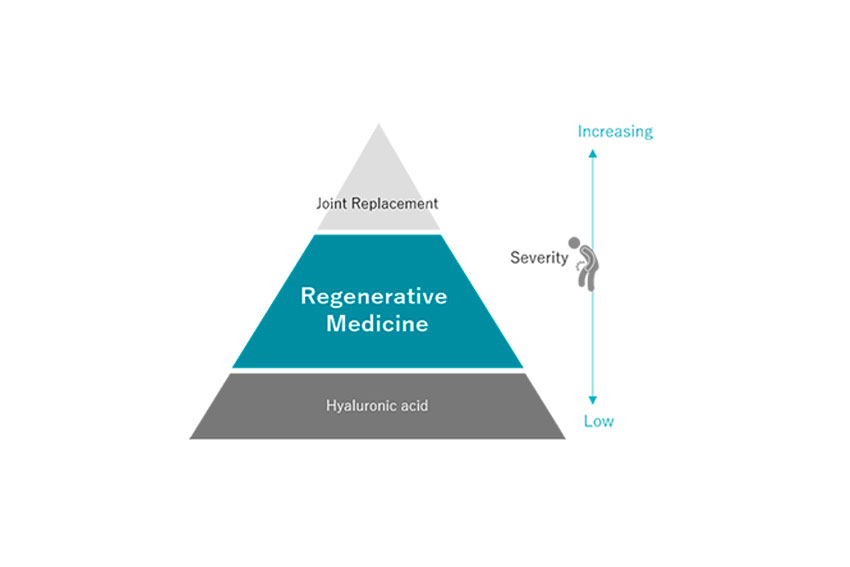Japanese firm CellSource is an innovative new healthcare service provider pioneering the industrialization of regenerative medicine, one of the groundbreaking new fields in the global medical industry.

Regenerative medicine – an interdisciplinary field combining engineering and life science principles to promote cell, tissue and organ regeneration – looks set to become one of the greatest developments in the medical industry in the 21st century and could revolutionize treatment over the coming years.
Amid the rapid rise in chronic diseases across the globe, as well as fast-aging populations in developed countries, regenerative medicine holds tremendous potential in the treatment of serious conditions including cancer, neurodegenerative disease, diabetes, heart disease, musculoskeletal disorders, and even respiratory failure caused by COVID-19 for which several FDA-approved clinical trials are ongoing.
With such rich potential to transform medical treatment, the regenerative medicine market – which is classified into cell-based immunotherapy & cell therapy products, gene therapy products, and tissue-engineered products – is projected to grow from $13.3 billion in 2019 to $38.7 billion 2024, representing a CAGR of 23.4%.
“In the future, regenerative medicine will play a vital role in the medical industry as it will be a novel approach to maximize the body’s own regenerative capabilities and to prevent our organs from b e c o m i n g permanently damaged. We hope to provide groundbreaking solutions for tissues and organs that may become severely damaged,” says Masato Tsumamoto, CEO of CellSource, one of the pioneering Japanese firms in the regenerative medicine field.
Japan has been at the forefront of regenerative medicine innovation mainly due to two factors. First, the fact that Japan has the world’s most aged population has prompted the country’s healthcare industry to pursue novel approaches for the treatment of diseases generally associated with older age groups, such as those aforementioned. Second is the Sakigake System, the world’s first regulatory framework implemented by the government in 2014 to promote the development of innovative medicine.
“In terms of R&D, clinical research/trials, and insurance coverage, Japan has created one of the most competitive ecosystems and has targeted innovative pharmaceuticals/medical devices which can treat and cure serious illnesses such as rare diseases and cancer,” explains Mr. Tsumamoto. “Therefore, the Sakigake System has opened up a completely new field in medical services, enabling companies to industrialize regenerative medicine and to offer innovative treatments legally.”
It was amid this thriving new ecosystem for medical innovation that CellSource was established in 2015. Aside from the Sakigake System, the implementation of the Regenerative Medicine Act (RM Act) has enabled companies such as CellSource, which went public in 2019, to accelerate the industrialization of regenerative medicine in Japan.
CellSource’s current business focuses on three areas: fat-derived stem cells, blood-based processing services and consulting services regarding regenerative medicine regulations, all of which fall under the company’s comprehensive support platform that allows health professionals at its partner institutions to focus solely on patient care.
Under the RM Act, medical centers, who previously had to do all the handling and processing of cells themselves, can now outsource these procedures to CellSource, making the process more cost-efficient and providing these centers with more time to spend with patients.
“CellSource has collaborated with various medical institutions and research institutions to establish a state-of-the-art platform in regenerative medicine that is available for all to utilize,” adds Mr. Tsumamoto.
“We are a new company which challenges to create universal value for the next generation while innovating without fear in today’s rapidly changing society. We work on the industrialization of regenerative medicine and contribute to the development of society: ‘In every life, regenerative medicine’.”
Japan, of course, is not the only country facing grave healthcare issues due to an aging population. And moving forward, CellSource aims to expand its services overseas and satisfy the rapidly growing demand for regenerative medicine worldwide.
“Our mid-term strategy is to continue growing. Japan contains around 18,000 orthopedic clinics, and we only work with about 350 at this moment. This gives us a wide opportunity to continue growing exponentially in Japan,” concludes Mr. Tsumamoto.
“We expect the value of regenerative medicine to be even higher by 2030, and it is for this exact reason that we expect CellSource to grow exponentially too. One of our goals for the next 10 years is to find overseas partners in order to export our services to the global market. By 2030, regenerative medicine will gain global popularity and CellSource will be at the center of this demand.”
0 COMMENTS